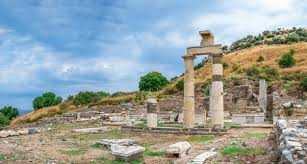Built during the time of Lysimachos, the Prytaneion is located to the west of the Odeion. The ruins surviving today date from the Augustan period (27 BC – 14). After undergoing restoration in the third century AD, the structure was finally destroyed in the fourth century.
The Prytaneion of Ancient Greek cities traditionally housed the sacred hearth and was used to host eminent visitors and envoys, as well as persons who had excelled on the battlefield or sporting events. It could also be described as a civic building. The sacred hearth of the Prytaneion was rended by stewards known as ‘Prytane’, whose job was to keep the fire burning continously. They performed their duties in the name of Hestia Boulea, the goddess of the hearth. The Prytans, who were chosen from among the city’s dignitaries and affluent classes, also supervised ritual ceremonies at the city’s other cult areas. All expenses incurred in the course of duty were paid for out of the Prytan’s personal wealth. The position of the Prytan therefore carried considerable status in the city.
Columns uncovered during excavations and since restored have been re-erected, complete with inscriptions citing the priests who served at the Prytaneion and various sacred hall of Ephesus, a square chamber with an altar and floors of marble. A statue of Hestia, who was patroness of the family as well as goddess of the hearth, has been recovered from the niche in front of the altar, and a statue of Athena from courtyard.
The Prytaneion was made up of a colonnaded courtyard and a suite of rooms around it. The courtyard led into a covered rectangular hall with Corinthian columns supporting the roof. Three of the columns survive today. In the fifth century AD, when the Prytaneıon had lost its function, columns belonging to the building were used in the renovation of the Baths of Varius.
These have since been unearthed in excavations and returned to their original site. The grand civic edifice served place for the ruling classes of Ephesus foreign visitors and leading members of the local wealthy elite. The inscription on columns found at the Prytaneion list the names of the city’s Curetes, a class of priests which varied in number. During the first week of every May, the priests would sef off from the Prytaneion and process to Orttgia, the mythical birthplace of Artemis discovered in the hall containing the sacred hearth are on display at the Ephesus Museum.
BANQUETING HALL
In the western section of the Prytaneion there are the ruins of a 14 x 11 meter building whose walls still stand to a height of 3.5 meters. The architectural features of the rooms in the southern part of the building suggest that they may have been used for gatherings. There are four more rooms in the eastern and northern sections. Researcher and excavations carried out in the eastern part of the rooms to the north have uncovered a rectangular pit in which various items of kitchenware were found. The included food and cooking vessels, as well as clay figurines and bone needles. The findings, which date from the first century AD, are displayed at the Ephesus Museum. The building underwent architectural changes in the third century AD and is thought to have been functionally linked to the Prytaneion.
CATHADOS: TO THE PRYTANEİON
The Cathodos, a Greek term used to denote ‘the way down’, is small street descending in a westerly direction from the Prytaneion. Lined on the south side by the walls of the Basilica Chaldidicum, the street leads on to the Square of Domitian. On the north side of the square is the Monument of Memmius. Before arriving at the Square of Domitian, the so-called Cathodos forms into a still-like structure. The sill is flanked on either side by similar pedestals decorated with reliers. The reliers looking towards the necropolis and the Precessional Way featured depictions of Hermes and his ram, while the other, facing the sill, portrayed the tripod of Apollo.

